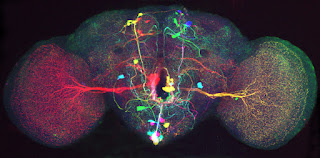 |
| Brainbow |
 |
| LSD Visions |
 |
| The Art of Neuroscience: Perception is Based on Your Own Brain |
Noe proclaims that it is our brain that allows us to see and interpret art that is around us. Depending on how your brain works, art will be viewed differently by others. Furthermore, Max talks about how our memories of the past are greatly shaped by sense of smell and the mood we are in, which are senses controlled by the brain. Hutton discusses the connections between art and the brain and how one influences the other; specifically, he gives an example how films are like memories created in the brain as it touches on our senses of mood, sight, feel, taste, etc. One thing is clear and it is that our brains are extremely powerful and can create these visions that we can interpret as we please. Whether it be dreams, hallucinations, or natural surrounding, our brain gives us the ability to create an exterior world that is unique to us.
References
References
Penrose, Roger. "The Third Culture - Chapter 14." The Third Culture - Chapter 14. 1995. Web. 15 May 2016. <https://www.edge.org/documents/ThirdCulture/v-Ch.14.html>.
Max, D.T. "Swann’s Hypothesis." The New York Times. The New York Times, 03 Nov. 2007. Web. 15 May 2016. <http://www.nytimes.com/2007/11/04/books/review/Max-t.html?_r=0>.
Noe, Alva. "Art and the Limits of Neuroscience." Opinionator Art and the Limits of Neuroscience Comments. The New York Times, 4 Dec. 2011. Web. 15 May 2016. <http://opinionator.blogs.nytimes.com/2011/12/04/art-and-the-limits-of-neuroscience/>.
Hutton, Noah. "Art and Neuroscience: A State of the Union." The Creativity Post. The Creativity Post, 10 Oct. 2012. Web. 15 May 2016. <http://www.creativitypost.com/arts/art_and_neuroscience_a_state_of_the_union>.
Uconlineprogram. "Neuroscience-pt1.mov." YouTube. YouTube, 17 May 2012. Web. 15 May 2016. <https://www.youtube.com/watch?v=TzXjNbKDkYI>.
No comments:
Post a Comment